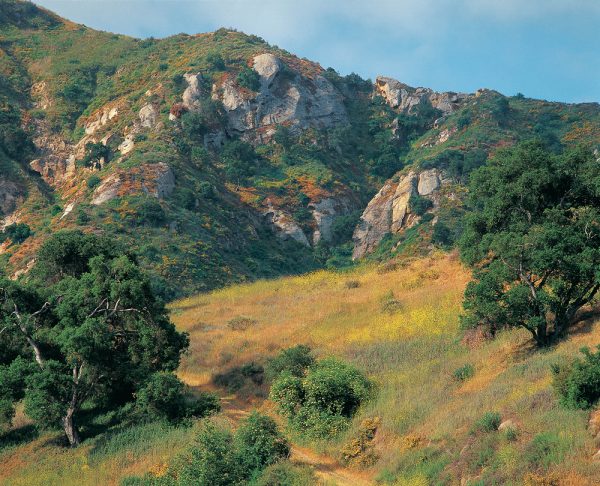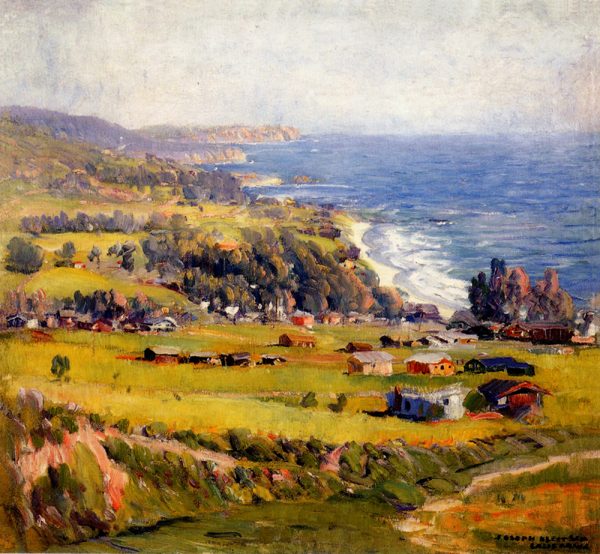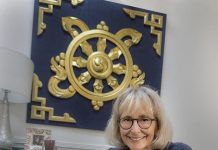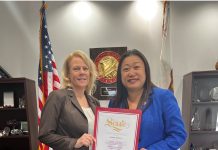
Photographer Tom Lamb had City Hall all to himself during the observance of Martin Luther King Jr.’s birthday this past Monday. Lamb roamed halls free of visitors and staff, photographing historic paintings that adorn hallways by iconic painters who had captured the early Laguna Beach landscape and its distinctive natural features. It is those works that helped establish the city as an art colony a century ago.
Accompanied by his wife Vickie and assistant city arts manager Mike McGregor, Lamb trained his camera on several works by Joseph Kleitsch, William Griffith, George Gardner Symons, Virginia Woolley and Roy Ropp, who founded the Festival of Arts and Pageant of the Masters.
The paintings are to be featured in a book about the Laguna Beach greenbelt, which recently gained status as a Historic American Landscape by the National Park Service.
The book, written by Laguna Beach writer Barbara Metzger, is titled “Laguna Beach and the Greenbelt, Celebrating a Treasured American Landscape.” The work is scheduled to be presented during the annual meeting of Laguna Greenbelt, a nonprofit established in 1968 to protect local wildlife habitat. The 7 p.m. event is set for Wednesday, Feb. 15, at the Congregational Church.
The book includes images of paintings in the collections of the Festival of Arts and Laguna Art Museum, said Lamb.

Last year, a group of local open space preservationists submitted documents to the National Park Service to include the Laguna Beach greenbelt in the Historical American Landscapes Survey, a national program established by the National Park Service in October 2000 to document historic landscapes in the United States and its territories to serve as tangible evidence of the nation’s heritage and development.
Laguna Wilderness Press director Ron Chilcote, landscape architects Ann Christoph and Bob Borthwick, art historian Eric Jessen, photographers Mark Chamberlain and Lamb, Metzger, former city council member Verna Rollinger, and Harry Huggins, a greenbelt historian and mapper, made the application.
It is now being processed at the Library of Congress in Washington, D.C. to be included into the permanent public HALS collection, Christopher Stevens, a landscape architect working with HALS and the National Park Service, said via email. It will be available to the public online in the near future, he said.
Documentation had been coordinated by Fullerton-based landscape architect Allison Terry. “I volunteered and just jumped in and learned and submitted the documents to Washington out of love for Laguna Beach. It’s unique in its topography, its limit on development and support of the historic preservation,” she said.
A member of the American Society of Landscape Architects, she said that the HALS survey membership is different from a historic registration. “This is a research tool for scholars, scientists and interested member of the general public; it does not put any restrictions on use of the land,” she said.
Stevens described prerequisites to inclusion in the survey: drawings, written histories, and large-format photographs.
Hence Lamb created high-resolution images that capture the coloration and lighting effects in the paintings. He relied on computer software to replicate the exact values of colors for printing and special filters to cut out interfering effects of dust and reflectivity of varnish.
Stevens also stressed that HALS is not a designation, offering no legal or government protection. “Historical landscapes are important touchstones of national, regional and local identity that foster a sense of community. They are also fragile places affected by forces of nature, by commercial and residential development, vandalism and neglect,” he wrote via e-mail. “For that reason it is important to document these places.”
According to Stevens, the 20,000-acre South Coast Wilderness Area, which partially encircles Laguna Beach and stretches from Newport Beach to Laguna Niguel, met all the qualifications to be included in the survey.
Landscapes, and those can include even nuclear test sites, must be at least 50 years old. It must have been associated with events that contributed to regional history and/or be associated with significant persons of the past or represent works of masters or high artistic values, hence the inclusion of plein-air paintings.
HALS, begun with the American Society of Landscape Architects, is a sister to the Historic American Buildings Survey established in 1933 and to the Historic American Engineering Record since 1969. So far there are 700 HALS sites, including Golden Gate Park, Yosemite, Rancho Los Alamitos, Long Beach, several missions, Washington monuments and Mount Vernon.
“We are all proud of our city and the legacy it carries for future generations. We saw an opportunity to convey our own feelings about the area to the world by giving a record for anyone to look at,” said Chilcote.





[…] recent designation of Laguna Beach and the Greenbelt in the Historic American Landscapes Survey by the National Park […]